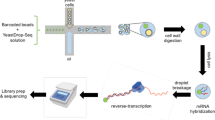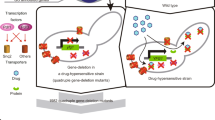Abstract
Intracellular metabolites and environmental agents continuously challenge the structural integrity of DNA. In the yeast Saccharomyces cerevisiae, the complete collection of open reading frame deletion mutants, in combination with powerful screening methods, allows for the comprehensive analyses of cellular responses to insult. We have developed a protocol to determine the sensitivity of growing yeast to DNA-damaging agents that is based on automatic measurements of the optical density of very small (100 μl) liquid cultures. This simple method is highly sensitive, provides quantifiable data and offers high-throughput screening capability. Starting with the treatment of cells with different doses of damaging agents, pre-prepared growing media containing 96-well plates are inoculated and cell population is automatically monitored every 10 min for 48 hours. With the aid of a multi-channel pipette, the sensitivity of a number of yeast strains to several concentrations of drug can be tested in triplicate in less then 4 hours.
This is a preview of subscription content, access via your institution
Access options
Subscribe to this journal
Receive 12 print issues and online access
$259.00 per year
only $21.58 per issue
Buy this article
- Purchase on Springer Link
- Instant access to full article PDF
Prices may be subject to local taxes which are calculated during checkout



Similar content being viewed by others
References
Hoeijmakers, J.H.J. Genome maintenance mechanisms for preventing cancer. Nature 411, 366–374 (2001).
Hanawalt, P.C., Ford, J.M. & Lloyd, D.R. Functional characterization of global genomic DNA repair and its implications for cancer. Mutat. Res. 544, 107–114 (2003).
Friedberg, E.C. DNA damage and repair. Nature 421, 436–440 (2003).
Suter, B., Auerbach, D. & Stagljar, I. Yeast-based functional genomics and proteomics technologies: the first 15 years and beyond. Biotechniques 40, 625–644 (2006).
Prakash, S. & Prakash, L. Nucleotide excision repair in yeast. Mutat. Res. 451, 13–24 (2000).
Hartwell, L.H. Yeast and cancer. Biosci. Rep. 24, 523–544 (2004).
Rieger, K.-J. et al. Large-scale phenotypic analysis in microtitre plates of mutants with deleted open reading frames from yeast chromosome III: key-step between genomic sequencing and protein function. Methods Microbiol. 28, 205–227 (1999).
Rieger, K.-J. et al. Chemotyping of yeast mutants using robotics. Yeast 15, 973–986 (1999).
Ross-Macdonald, P. et al. Large-scale analysis of the yeast genome by transposon tagging and gene disruption. Nature 402, 413–418 (1999).
Warringer, J. & Blomberg, A. Automated screening in environmental arrays allows analysis of quantitative phenotypic profiles in Saccharomyces cerevisiae. Yeast 20, 53–67 (2003).
Toussaint, M. et al. A high-throughput method to measure the sensitivity of yeast cells to genotoxic agents in liquid cultures. Mutat. Res. 606, 92–105 (2006).
Conconi, A. et al. Mitotic viability and metabolic competence in UV-irradiated yeast cells. Mutat. Res. 459, 55–64 (2000).
Winzeler, E.A. et al. Functional characterization of the S. cerevisiae genome by gene deletion and parallel analysis. Science 285, 901–906 (1999).
Giaever, G. et al. Functional profiling of the Saccharomyces cerevisiae genome. Nature 418, 387–391 (2002).
Steinmetz, L.M. et al. Systematic screen for human disease genes in yeast. Nature Genet. 31, 400–404 (2002).
Warringer, J. et al. High-resolution yeast phenomics resolves different physiological features in the saline response. Proc. Natl. Acad. Sci. USA 100, 15724–15729 (2003).
Dielbandhoesing, S.K. et al. Specific cell wall protein confer resistance to Nisin upon yeast cells. Appl. Environ. Microbiol. 64, 4047–4052 (1998).
Aouida, M. et al. Comparative roles of the cell wall and cell membrane in limiting uptake of xenobiotic molecules by Saccharomyces cerevisiae. Antimicrob. Agents Chemother. 47, 2012–2014 (2003).
Osterberg, M. et al. Phenotypic effects of membrane protein overexpression in Saccharomyces cerevisiae. Proc. Natl. Acad. Sci. USA 103, 11148–11153 (2006).
Warringer, J. & Blomberg, A. Involvement of yeast YOLI51W/GRE2 in ergosterol metabolism. Yeast 23, 389–398 (2006).
Caesar, R., Warringer, J. & Blomberg, A. Physiological importance and identification of novel targets for the N-terminal acetyltransferase NatB. Eukaryot. Cell 5, 368–378 (2006).
Ericson, E. et al. Genetic pleiotropy in Saccharomyces cerevisiae quantified by high-resolution phenotypic profiling. Mol. Gen. Genomics 275, 605–614 (2006).
Fernandez-Ricaud, L. et al. PROPHECY — a database for high-resolution phenomics. Nucl. Acids Res. 33, D369–D373 (2005).
Lehmann, A.R. Replication of damaged DNA by translesion synthesis in human cells. FEBS Lett. 579, 873–876 (2005).
Sancar, A. Molecular mechanisms of mammalian DNA repair and the DNA damage checkpoints. Annu. Rev. Biochem. 73, 39–85 (2004).
Acknowledgements
We thank Dr. K. Kobryn for critical reading of the manuscript and the Centre Génomique Fonctionelle de Sherbrooke for helpful discussions. The software was developed by J. Gervais-Bird (Génome Québec and Genome Canada). M. Toussaint is a recipient of a NSERC fellowship and this work was supported by a grant from the Natural Sciences and Engineering Research Council of Canada (NSERC) to A.C.
Author information
Authors and Affiliations
Corresponding author
Ethics declarations
Competing interests
The authors declare no competing financial interests.
Rights and permissions
About this article
Cite this article
Toussaint, M., Conconi, A. High-throughput and sensitive assay to measure yeast cell growth: a bench protocol for testing genotoxic agents. Nat Protoc 1, 1922–1928 (2006). https://doi.org/10.1038/nprot.2006.304
Published:
Issue Date:
DOI: https://doi.org/10.1038/nprot.2006.304
This article is cited by
-
Two homologs of the Cat8 transcription factor are involved in the regulation of ethanol utilization in Komagataella phaffii
Current Genetics (2021)
-
The P-glycoprotein repertoire of the equine parasitic nematode Parascaris univalens
Scientific Reports (2020)
-
Oxidation and alkylation stresses activate ribosome-quality control
Nature Communications (2019)
-
A simple and inexpensive quantitative technique for determining chemical sensitivity in Saccharomyces cerevisiae
Scientific Reports (2018)
-
Evaluation of in vivo antioxidant potential of Syzygium jambos (L.) Alston and Terminalia citrina Roxb. towards oxidative stress response in Saccharomyces cerevisiae
Journal of Food Science and Technology (2018)
Comments
By submitting a comment you agree to abide by our Terms and Community Guidelines. If you find something abusive or that does not comply with our terms or guidelines please flag it as inappropriate.



